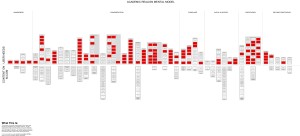Not All of Austin’s Growth is Annoying — The New Development I Loved Best in Austin Last Year

What did you love best about Austin in 2014?
While Austinites tend to complain about the growth in and around the city, there’s also a lot to love in this ever-growing, ever-changing metropolis — with what looks like a dozen cranes crisscrossing the downtown skyline.
So many new restaurants opened (Dai Due, anyone?). So many festivals (one or two a week on average!). So much art, music, theater, sports, food, and more.
I loved so many of our city’s new developments last year.
But one new feature of our fair city in 2014 tops my list — the opening of the new boardwalk around Town Lake (yes, I still call it Town Lake).
The Town Lake Treasure
Since I moved to Austin I’ve loved the hike and bike trail. It’s been my refuge. I used to live in the far southwest part of town, so had to drive to ride or walk the trail. Now I can ride my bike or walk to it.
While, in the past, I would often ride deep into the east side, I usually only cycled as far as the old Holly Street Power Plant (which looked like a Mad Max film set), where I would turn around and ride back.
The few times I circled the lake left me hating the trip, thanks to having to cross 35 and ride along busy Riverside Drive. It just wasn’t fun.
I preferred to just back track on the actual riverside trail. That stretch from 35 to the plant through the lush, green, waterfront of Festival Beach was one of my favorites anyway.
Then on June 7 a miracle happened. The long discussed, long construction project was finally complete. The magical Town Lake boardwalk opened with a party.
I missed the party, but about one week later decided to finally check out the boardwalk on my bike. I rode down to the trail and began my familiar ride heading east.
The first thing I noticed was a lot more people on the trail than in the old days.
I was a little apprehensive after I passed the now-defunct Holly Power Plant, because I hadn’t been to this part of town in a long time.
But the beauty of that side of Town Lake wrapped me in its arms and I continued toward my destination — the boardwalk.
Love at First Sight
After rounding the east end of the lake and passing the lakeside hostel (digs for lucky broke young travelers!), I hit the east-most end of the boardwalk. Then I commenced my 1.1-mile journey down the boardwalk.
It was glorious. All green on one side, blue water on the other, and stellar views of the city.
Austin did itself proud on this project. I couldn’t love it more.
In fact, I loved the boardwalk and full-circle trail around the lake so much that I started riding every single day. When it got too hot by July to ride in the evenings, I started waking up at 6:00 a.m. to ride.
I’m notoriously not a morning person, so this proves just how much I love the ride.
These days, if it’s above 50-degrees, you’ll find me riding the loop around 5:00 p.m. Let me know if you want to join me!
For an awesome view of the boardwalk from a cyclist’s perspective, check out this short video a biker shot with GoPro.
If you haven’t visited the boardwalk yet, here’s some information for planning your adventure.


